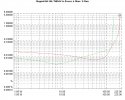- Thread Starter
- #161
Is setting -95,-105,-115,-125 dB or even lower "large nonlinearity" which "introduces large inharmonic IMD components"? Because result is louder. A lot louder.
I think it is because "PKH automatically adjusts the level after each change". Even if it is not needed. And this is probably also one of the reasons why many like it. It is louder.
Let's just back that claim by some measurements, shall we? First, let's record a piece of music (Beatles, Sgt. Pepper) with a large nonlinearity dialed in (around -45dB THD):
Let's measure the RMS level of the track as it's recorded by Audacity:
Now, do the same but with all harmonics set to -200dB:
You tell me if the difference of less than 0.1dB over a track of real music, unweighted, represents "A lot louder" like you claim.
And just to confirm, I matched the two tracks in DeltaWave to measure the true level differences. The spectrum below shows the raw waveforms and the overall level difference between them is 0.0456dB. Is that "a lot louder"?
Last edited:

